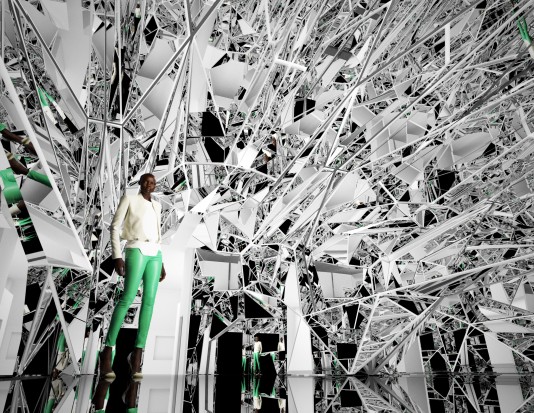Gage/Clemenceau Architects use Autodesk Design Suite to create a Fashion Week Installation for Lady Gaga Fashion Director Nicola Formichetti. Mudbox and Maya were key to creating the final design.
Architectural firm Gage/Clemenceau Architects recently used Autodesk Design Suite software to conceptualize, design and create a one-of-a kind immersive retail and display environment for Lady Gaga Fashion Director Nicola Formichetti. The environment will house the new work of Formichetti, as well as some of his previous work including several projects for pop singer Lady Gaga.

The project, which is showing through September 21, 2011 in New York City during the city’s famed Fashion Week, is the result of the BOFFO Building Fashion, a nonprofit initiative supporting artists and designers to produce public arts projects. The installation is an experimental fusion of ideas from both fashion and architecture into a new type of physical environment. Comprised of hundreds of robotically cut, mirrored facets that seemingly explode from ceilings, walls and flooring, the endlessly reflective environment captures and refracts Formichetti’s work. This allows his fashion designs to be viewed from many unexpected perspectives and become an active participant in the environment.
Principal Architect Mark Foster Gage led the project—an experimentation vehicle for the nontraditional firm, which works to combine architectural practice with the innovative use of emerging technologies. The firm is a long-time user of Autodesk software and took advantage of several products in Autodesk Design Suite Premium 2012—including AutoCAD, Autodesk 3ds Max Design, Autodesk Mudbox and Autodesk Showcase—for the Formichetti installation.
Gage said, “Autodesk has done what no other software company can do. They have an extensive array of software for different creative industries—like entertainment, design and architecture—and combined them into a single powerful package, so that we now have all of these tools at our fingertips. They have made it easy for us to translate designs between programs, so we can go from one way of looking at something to another. That kind of cross-discipline thinking is what this project was all about.”
Gage/Clemenceau Architects used the Autodesk Design Suite, along with Autodesk Maya software, to conceptualize, design and visualize the installation. Gage gave design sketches to two small teams: one working in Mudbox digital sculpting and painting software and one working in Maya 3D animation software. This enabled them to explore radically different approaches to their original concept. The Maya team used the software’s polygonal modeling tools to produce a design with very precise facets that looked futuristic and sharp. The Mudbox team used the product’s digital sculpting capabilities to create a highly organic design in which the triangular shapes appear rounded and melted. Gage noted that while Mudbox isn’t used widely in architecture today, he finds it invaluable in enabling architects to get very close to their designs, shaping them like clay.
The firm used the real-time 3D capabilities of Autodesk Showcase presentation software to quickly visualize the highly reflective surfaces that were at the foundation of the environment. Autodesk 3ds Max Design software was then used to create richly detailed near photo-realistic renderings for reviews with Formichetti. The firm also used AutoCAD software to develop all the plans, sections and elevations. To meet the tight deadlines of the competition submission, Gage/Clemenceau Architects sent its CAD files directly to a computer numerical control (CNC) milling machine—producing a physical form in four days versus the weeks it would have taken to cut it out by hand.
“Working this way really opens up a whole new wealth of possibilities for architecture,” Gage said. “Software is the Rosetta Stone that lets designers, architects and artists from all arenas translate our expertise from one discipline to another. We moved very quickly from Mudbox to 3ds Max Design to AutoCAD—all because these tools are combined into a cohesive bundle. Autodesk lets us all speak the same geometric language, so collaboration and exploration is faster and easier.”
“This project is exciting because of the ways it fosters collaboration,” said Phil Bernstein, vice president Industry Strategy & Relations, Autodesk AEC Solutions. Bernstein, who is a faculty member at the Yale School of Architecture with Gage added that “Gage/Clemenceau Architects is at the forefront of a new generation of architects who tap technology to create in new ways. Formichetti approaches fashion design differently, striving to make fashion immersive rather than exclusionary. BOFFO brings different artistic disciplines together to produce an entirely new result.”
BOFFO’s Building Fashion competition explores the intersection of architecture and fashion by pairing fashion designers with architects to build temporary installations. Five top designers presented their visions for a space to feature their work, and 125 architects posted installation designs for review and selection for the five spots. For its installation, Gage/Clemenceau Architects sought to not only showcase Formichetti’s designs, but also to magnify their impact through the creation of an immersive environment that fused architecture with fashion.





